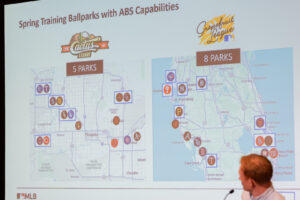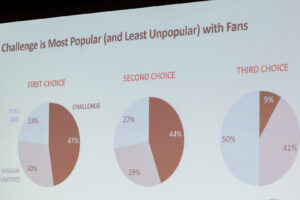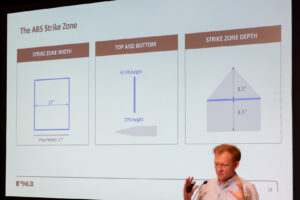- Slug: Sports–MLB Rule Changes. 1,660 words.
- Photos available.
By Tyler Bednar
Cronkite News
PHOENIX – Major League Baseball, the oldest sports league in the country, is steeped in tradition, but often resistant to change.
From fans singing “Take Me Out to the Ball Game” in the middle of the seventh inning to ceremonial first pitches by celebrities, baseball is known for traditions that make the game fun.
However, the sport has resisted change, especially when it comes to the rules. And as baseball, once known as America’s pastime, watched the popularity of football and basketball surge, it was shaken out of its stubborn streak.
Over the past few years, baseball has undergone radical changes to speed up games and improve the viewing experience for fans. And the major leagues have found the perfect laboratory to experiment with changes.
The Arizona Fall League – an offseason league made up of top prospects from every organization in baseball – unfolds in the desert from October to November. As those players use the league to prove their value and improve their skills, baseball uses AFL games as a proving ground for rule changes that are positively impacting the sport.
The pitch clock, bigger bases, mound visit limits and shift bans all were tested in the Arizona Fall League before they were implemented at the major league level.
Now, the Automated Ball-Strike Challenge System is making its next step up the ladder. After being tested in the Arizona Fall League last year and the minor leagues since 2021, ABS will be implemented in 13 spring training ballparks — five at the Cactus League and eight at the Grapefruit League, according to Morgan Sword, executive vice president of baseball operations.
At this year’s Cactus League spring training media day availability, all 15 managers answered questions from media members. Overall, managers were intrigued to experience the system in person.
“I’m interested in seeing how it works,” said Ron Washington, manager of the Los Angeles Angels. “Every kid that I’ve talked to that (has) come up from the minor leagues, they like it. I still think the umpires do a tremendous job. They don’t have a whole lot of time to make a decision, but most of the time they’re right.”
Pitchers, catchers and hitters — the only people who are allowed to initiate a challenge — are being encouraged by league officials to try out the new system. Players will have one to two seconds to tap their hat or helmet, which will initiate a challenge on the pitch. The result of the challenge will appear on the scoreboard.
Each team will be allowed two challenges per game and will be allowed to retain successful challenges.
“I talked to our minor league staff about it,” said Mike Shildt, San Diego Padres manager. “We’re not going to spend too much time figuring out how we’re going to use it and our strategy behind it, there is some strategy behind it, but I’m really really curious.
“I like what Major League Baseball has done with the pitch clock, and I’m curious to see just how this works into the game.”
The new rule will not be in play during the 2025 regular season. The earliest ABS will be introduced to major league regular season games is 2026, but the timetable will be determined by multiple factors.
The Los Angeles Dodgers and Chicago Cubs will compete in the first MLB spring training game with ABS Thursday at Camelback Ranch.
ABS uses Hawk-Eye Camera Technology to determine whether a pitch is a strike, based on each batter. In 2023, the Fall League implemented a new change that places the strike zone based on the median stance of a batter from their previous 50 plate appearances.
Fall League players showcased similar support for the limited challenge system as the managers at spring training media availability.
“I think it adds a part of the game that you’ve never really seen before that kind of makes it exciting for the offensive and defensive side of the ball that can ultimately change big situations,” said Chase DeLauter, an outfielder in the Guardians organization who is ranked as the No. 36 prospect in baseball by MLB.com.
The ultimate goal of ABS is to allow teams to challenge subjective calls made by umpires. It’s difficult, even for a very experienced umpire, to get every call correct.
Fall League players showcased support for ABS, as opposed to full ABS. This sentiment runs true with fans and players/coaches at the Triple-A level. A poll indicated that the challenge system was most favored by fans and Triple-A players and coaches.
“I really like how it is right now. I really like how it’s working,” Cubs catcher Moises Ballesteros said through a translator. “I don’t think it’d work if you can challenge every single pitch. I think two (or) three challenges (per) game is a good experience. … I like to play the old-school ballgame, and I think if we bring all that to every single pitch, then we’re going to stop playing the OG baseball that we play.”
A full ABS would essentially limit the use of human umpires – important figures in baseball – behind home plate. In a full ABS system, umpires would make calls entirely based on what the system tells them for every pitch.
“I feel there should be umpires in the game,” Guardians prospect Allan Hernández said. “I think it would be a weird feeling to have everything robotic and whatnot, so umpires should stay.”
One of the most challenging and subjective calls in baseball could be gone soon, too. There isn’t a concrete definition of a check swing, which allows the call on the field to be subjective and can differ from umpire to umpire.
The 2021 San Francisco Giants, who led the majors with 107 wins in the regular season, had their season ended in the NL Division Series on Wilmer Flores’ check swing against the Dodgers. The play resulted in conversations regarding what constitutes a check swing.
Using the same Hawk-Eye Technology used for ABS, players can challenge to see whether a player exceeds a 45-degree angle from home plate, according to a report by MLB.com’s Sam Dykstra.
While DeLauter hasn’t seen the system in place, he is a fan of the concept.
“I personally haven’t used it or seen it while I’ve been playing yet,” DeLauter said. “The bat moves fast. It’s hard for the human eye to see that. That’s kind of one of the things that I feel like has to be tracked to get the perfect call.
“Same thing with ABS, if you can do it accurately and really read it with Hawk-Eye or however they’re doing it, I think, no question, it helps the game a little bit.”
Earlier rule changes tested in the Arizona Fall League before being introduced to MLB have proven popular.
The base size increased from a 15-inch square to an 18-inch square in the 2023 season. The rule was primarily established to lessen the risk of player collisions, especially when there is a close play at first base.
The size change reduced the distance between first, second and third base by 4 1/2 inches to encourage more stolen bases.
New pickoff rules were implemented at the same time, which has also contributed to an increase in stolen bases. Pitchers are only allowed two disengagements per plate appearance. If a pitcher makes three disengagements and the runner isn’t thrown out, a balk is called and all runners advance one base.
“That’s why you’re seeing guys like Shohei Ohtani stealing 59 bases, where nobody was running like that before,” said USA Today baseball columnist Bob Nightengale. “If that rule was in place when guys like Rickey Henderson played, they might have stolen 150, 200 bases a year every single year.”
MLB players stole 3,617 bases in 2024, the most in a single season since 1915. Six players have stolen 50-plus bases in a season since 2023, which hadn’t happened since Dee Strange-Gordon and Billy Hamilton both snagged 50 bases in 2017.
Additionally, the pitcher engagements rule has helped to shorten the average game time. In previous seasons, pitchers would disengage multiple times during the same at-bat, especially against faster base runners to keep them from getting an expanded lead.
The most consequential rule change, the pitch clock, helped bring fans back into the stadium. In 2021 and 2022, the two seasons before the pitch clock was introduced, baseball games lasted an average of more than three hours, impacting attendance.
In 2022, just more than 64.5 million fans attended games during the MLB regular season, the lowest attendance in a full season without restrictions since 1997.
Two years later, the average game length dropped by 28 minutes to two hours, 38 minutes. Attendance leaped above 71 million, the most since 2017.
“The time of the game was getting over three hours, attendance was dropping, TV ratings were plummeting, baseball was losing its fan base, getting surpassed for years by football, getting surpassed by basketball,” Nightengale said.
These rules were put in place to make the game more easily watchable for the casual fan, while also making sure diehard fans remained invested in the game.
The game’s overall increase in popularity was also on display during the most recent World Series. The Fall Classic matched the Dodgers against the New York Yankees, baseball’s biggest brands.
The 2024 World Series averaged 15.8 million viewers between Fox and Fox Deportes – the highest average number of viewers since the 2017 Series between the Dodgers and Houston Astros.
Much of baseball’s newest rules have come with the addition of new technology. Despite the game’s value in tradition, what matters most is baseball gets consequential calls correct.
“Today, I can’t imagine baseball without instant replay,” said Torey Lovullo, manager of the Arizona Diamondbacks. “Get the plays right, and that’s all we want at the end of the day. It’s to get things right and move the game forward.”
Thanks to popular rule changes that were given the stamp of approval in the Arizona Fall League, and perhaps because of future changes tested there, baseball has its rally cap on.
For more stories from Cronkite News, visit cronkitenews.azpbs.org.



